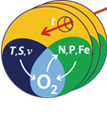SUBPROJECT - A2
High-resolution modelling of physical-biogeochemical interactions in the tropical ocean: determination of potential future trends
The high-resolution global ocean model configurations developed in the 2nd phase will be utilized (i) to aid the interpretation and synthesis of local observations by providing a coherent and dynamically consistent spatio-temporal context; and (ii) to obtain refined projections of the 21st-century changes that may be expected in the Pacific and Atlantic OMZs as a consequence of anthropogenic climate change. More specifically, while the A2- modelling program in the 2nd phase was concerned with the testing of hypotheses for the observed OMZ-trends during the past decades (e.g., the effect of multi-decadal changes in tropical wind fields and their impact on subtropical-tropical transports of nutrients and oxygen), the goal in the 3rd phase will be to use the high-resolution (1/10°) physical- biogeochemical model system to investigate the response of ocean physics and biogeochemistry to the atmospheric trends projected by climate models of the IPCC 5th assessment report (CMIP5). The main “projection”-experiments will be complemented by case studies (‘what if experiments’) looking at specific effects of changes in individual forcing components, such as a progressing trend in the Pacific trade winds (trend in the Walker circulation), trends in the Southern Ocean winds, and a possible decline in the Atlantic Meridional Overturning Circulation.
The investigation of basin-scale mechanisms and response behaviours will be complemented (iii) by a program of experiments focusing on the role of the recently documented, small- scale transport processes and benthic-pelagic interactions in the main observational study area off Peru. These experiments will utilize the high-resolution, regional model formulated in terrain-following vertical coordinates (ROMS) that was developed in recent years via a joint EUROCEANS and SFB 754 effort. Lateral boundary conditions will be provided by the global (NEMO-based) model and thereby also allow a examination of the regional repercussions of global warming scenarios along the continental margin off Peru.
References
Duteil, O., C.W. Böning and A. Oschlies (2015) Variability in subtropical-tropical cells drives oxygen levels in the tropical Pacific Ocean. Geophys. Res. Lett., doi: 10.1002/2014GL061774
Duteil, O., F.U. Schwarzkopf, C.W. Böning and A. Oschlies, (2014) Major role of the equatorial current system in setting oxygen levels in the eastern tropical Atlantic Ocean: a high-resolution model study. Geophys. Res. Lett., 41, 2033-2040, doi: 10.1002/2013GL058888
Duteil, O., W. Koeve, A. Oschlies, D. Bianchi, E. Galbraith, I. Kriest and R. Matear (2013) A novel estimate of ocean oxygen utilisation points to a reduced rate of respiration in the ocean interior. Biogeosciences, 10 (11), 7723-7738, doi: 10.5194/bg-10-7723-2013
Kriest, I., A. Oschlies und S. Khatiwala (2012) Sensitivity analysis of simple global marine biogeochemical models. Glob. Biogeochem. Cy., 26, GB2029, doi: 10.1029/2011GB004072
Landolfi, A., H. Dietze, W. Koeve and A. Oschlies (2013) Overlooked runaway feedback in the marine nitrogen cycle: the vicious cycle. Biogeosciences, 10, 1351-1363, doi: 10.5194/ bg-10-1351-2013
McGregor, S., P. Spence, F.U. Schwarzkopf, M.H. England, A. Santoso, W.S. Kessler, A. Timmermann, C.W. Böning (2014) ENSO-driven interhemispheric Pacific mass transports. J. Geophys. Res., doi: 10.1002/2014JC010286
Montes, I., B. Dewitte, E. Gutknecht, A. Paulmier, I. Dadou, A. Oschlies and V. Garçon (2014) High-resolution modeling of the Eastern Tropical Pacific oxygen minimum zone: Sensitivity to the tropical oceanic circulation. J. Geophys. Res. Oceans, 119, 5515-5532, doi: 10.1002/ 2014JC009858
Patara, L. und C.W. Böning (2014) Abyssal ocean warming around Antarctica strengthens the Atlantic overturning circulation. Geophys. Res. Lett., 41(11), 3972-3978, doi: 10.1002/ 2014GL059923
Stramma, L., A. Oschlies and S. Schmidtko (2012) Mismatch between observed and modeled trends in dissolved upper-ocean oxygen over the last 50 yr. Biogeosciences, 9, 4045-4057, doi: 10.5194/bg-9-4045-2012
Contact:
Prof. Claus Böning Prof. Andreas Oschlies
Tel.: +49 431 600 4003 Tel.: +49 431 600 1936
cboening(a)geomar.de aoschlies(a)geomar.de




